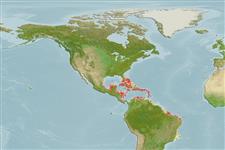Common names from other countries
Environment: milieu / climate zone / depth range / distribution range
นิเวศวิทยา
เกี่ยวกับทะเล,น้ำเค็ม เกี่ยวกับหินโสโครก; ระดับความลึก 0 - 5 m (Ref. 9710). Subtropical
Western Atlantic: southern Florida (USA), Bahamas, and Yucatan, Mexico to northern South America.
ขนาด / น้ำหนัก / Age
Maturity: Lm ? range ? - ? cm
Max length : 6.0 cm TL เพศผู้/กระเทย; (Ref. 7251)
เงี่ยงครีบหลัง (รวม) : 20 - 21; ก้านครีบอ่อนที่หาง (รวม) : 11; เงี่ยงครีบก้น: 2; ก้านครีบอ่อนที่ก้น: 19 - 20. Body with dark bars; first two bars connected to form an H, last two bars remote from first (Ref. 26938).
Inhabits limestone rock, rubble and coral reef areas. Usually near sea urchins (Ref. 9710). Feeds on amphipods and copepods (Ref. 13628).
Life cycle and mating behavior
Maturities | การสืบพันธุ์ | Spawnings | Egg(s) | Fecundities | ตัวอ่อน
Robins, C.R. and G.C. Ray, 1986. A field guide to Atlantic coast fishes of North America. Houghton Mifflin Company, Boston, U.S.A. 354 p. (Ref. 7251)
IUCN Red List Status (Ref. 130435)
CITES (Ref. 128078)
Not Evaluated
Threat to humans
Harmless
Human uses
เครื่องมือ
Special reports
Download XML
แหล่งที่มาจากอินเตอร์เน็ต
Estimates based on models
Preferred temperature (Ref.
115969): 26.4 - 28.2, mean 27.5 (based on 541 cells).
Phylogenetic diversity index (Ref.
82804): PD
50 = 0.5000 [Uniqueness, from 0.5 = low to 2.0 = high].
Bayesian length-weight: a=0.00912 (0.00399 - 0.02083), b=3.06 (2.87 - 3.25), in cm Total Length, based on LWR estimates for this (Sub)family-body shape (Ref.
93245).
ระดับชั้นอาหาร (Ref.
69278): 3.2 ±0.36 se; based on food items.
Fishing Vulnerability (Ref.
59153): Low vulnerability (10 of 100).
